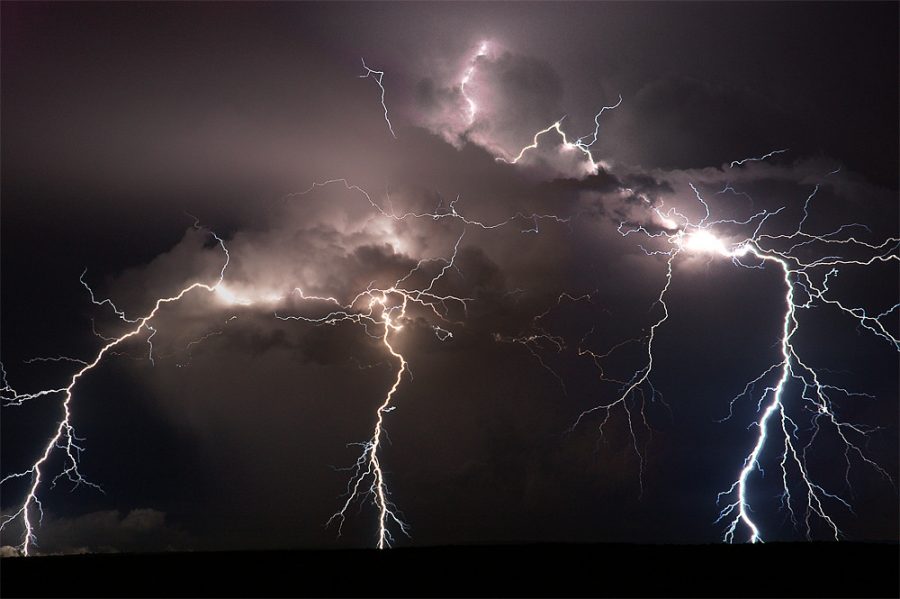Lightning
Source: b_napper
“Lightning Composite” by b_napper is licensed under CC BY-NC 2.0
Lightning, while scary and dangerous, is a beautiful sight. Many people ask, “How is lightning created, and how does it light up in the sky?” Lightning can be very dangerous and may harm people and animals, depending on the environment and the power of the stroke sent. This report will give information on lightning and give a better understanding of this weather phenomenon.
All lightning is formed in a region of a cloud that has an excessive amount of electrical, positive, and negative charge. These charges will then develop inside the cloud. There are different regions of a cloud, each holding different amounts and types of electrical charge. The top of the cloud usually has a more positive charge than the rest of the cloud. The middle part of the cloud has the most negative charge. Last but not least, the lowest part of the cloud has small amounts of positive charge. These charges, when joined with ice and water particles will then produce static.
Cloud to Ground Lightning
Cloud to ground lightning has two forms. These two forms include both positive, and negative charges. Cloud to ground lightning is formed when a breakdown of the positive charges in the lower region of the cloud and the negative charges in the middle of the cloud, breakdown. When the charges both break down, a “channel of partially ionized air”① is created. This causes non-electrically charged atoms to become electrically charged. Then “stepped leader,” which is the first stroke of lightning you see, strikes down and then connects to the ground. Most stepped leaders are negatively charged. When the stepped leader is close to the ground, it returns to the cloud, and the opposite charge (negative-positive, positive-negative) meets the first strike at a sudden point in the air. The average height in the air that the two strikes meet each other is around 30 meters (98 feet) in the air. When the circuit is complete, a bright “return stroke” flashes. This is the actual lightning that the human eye observes. Sometimes, multiple consecutive strokes can happen, reminding us of nature’s power.
Other types of lightning
Another type of lightning is ground to cloud lightning. Ground to cloud lightning is “a discharge between cloud and ground, initiated by an upward-moving leader.”② Ground to cloud lightning has a tendency to hit taller buildings, such as towers or skyscrapers. A unique thing about ground to cloud lightning is that it can be positive or negative without affecting the form of lightning that it becomes.
Anvil Crawler
The Anvil Crawler is another type of lightning that is different in its own way. An Anvil Crawler is unique because of the way the stroke moves. The Anvil Crawler has one stroke of lightning break off in a way a tree’s roots look like. Another unique thing about an Anvil Crawler is that people are able to catch it on video. Anvil Crawler lightning covers a huge distance, so they have an immense amount of time returning to the cloud that they had come from. This time takes enough time for the human eye to see it and slow enough to catch on video.
Bolt from the Blue lightning
Bolt from the Blue lightning is a bolt of lightning that strikes far away from the thunderstorm. Bolt from the Blue lightning comes from the highest part of a cumulonimbus cloud. These strokes are able to strike as far away as 10 miles in completely blue skies!
Intracloud Lightning
Intracloud Lightning is when one stroke of lightning jumps between different regions of the cloud (top, middle, bottom). Intracloud Lightning has a second name, which is sheet lightning. Intracloud Lightning can happen inside the cloud, so it can be harder to see with the naked eye.
Bead Lightning
Bead Lightning is lightning, where a lightning channel starts to decay and breaks up into multiple channels of light. Most lightning will become bead lightning after the return stroke cools down. Bead lightning is more of an after stage of lightning than its own type. Bead lightning is hard to see with the naked eye, but it is easier to see if the spectator is close to the strike or if they use a telescope. It is not good to actually get close to Bead Lightning, though, because it can still fry someone alive!
Facts and Conclusion
Now that some of the different lightning types have been discussed, we come to the conclusion. First, here are some interesting facts about lightning. Lighting is that a strike can range from 10 to 100 million volts! The return stroke can reach temperatures of 50,000℉, and around 50 to 100 lightning strikes happen every second! So that was my report on lightning, and after reading this, I hope I have made you more knowledgeable of lightning!
Citations/Bibliography:
Robinson, Dan. “Weather Library > Lightning Types and Classifications.” Storm Highway by Dan Robinson, 2012, stormhighway.com/types.php.
“Lightning.” Britannica School, Encyclopædia Britannica, 25 Nov. 2015. school.eb.com/levels/high/article/lightning/48228. Accessed 29 Nov. 2018.
Geographic, National. “Lightning Facts and Information.” National Geographic, National Geographic, 9 Oct. 2009, www.nationalgeographic.com/environment/natural-disasters/lightning/.
Quotes:
Britannica School:①
Storm Highway:②















